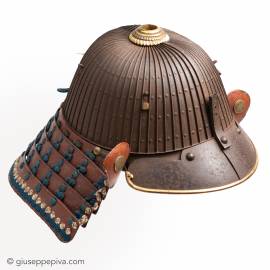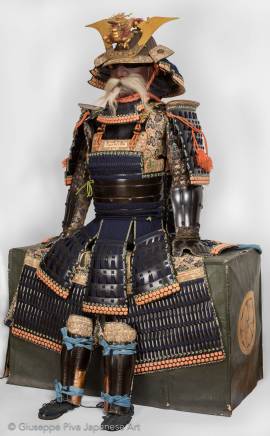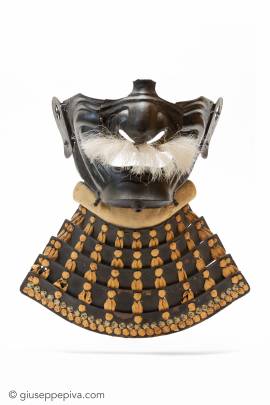A russet iron samurai helmetMid Edo period, 18th centurySigned: Jōshū jū Saotome IeharuProvenance:L. Taelman CollectionLiterature:T. Orikasa, Helmets of the Saotome School, 2010, pp. 104-105Rare 62-plate helmet joined with five rows of visible rebated rivets. Inside is the "Saotome-byo," an additional rivet used almost as a signature by armorers of the Saotome school.The shikoro (neck guard) is original, consisting of five plates covered in red leather and folded at the front to form two small fukigaeshi bearing a kamon (family crest) showing two crossed hawk feathers. ...
WORKS FOR SALE
Samurai armor signed Myochin MuneakiOkegawa-do tosei gusokuLate Edo period (1615-1867), 19th centuryThis Japanese armor features a good heavy sujibachi-kabuto made our of 24 riveted plates, adorned with an excellent gilt-wood dragon maedate and fitted with a hon-kozane shikoro (neck protection). The signature inside the helmet reads “Myochin ki Muneaki” and belongs to an armorer from the Myochin school who worked in Himeji (Harima) during the latter part of the Edo period. The kamon (family crest) of the Sakai family, for whose he worked, is printed on the two leather covers of...
Samurai armor’s mask with fierce expressionMyōchin schoolMid Edo period18th century This unusual me-no-shita type (half face, literally "under the eyes") samurai mask features a fine hammered surface that is embossed to create lengthy, deep, and sharp wrinkles across the entire face. The nose is rather large, and the chin is massive, as is typical of menpo mad by Myōchin armorers.The interior's gold lacquer indicates an important provenance.
Copyright © 2016 - giuseppe piva - VAT: 05104180962










